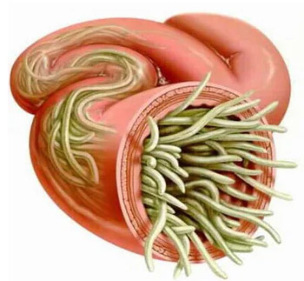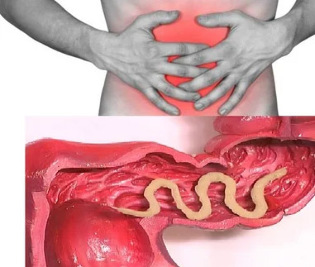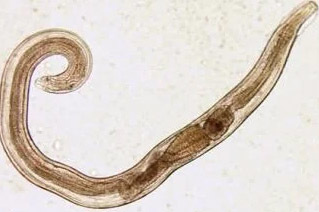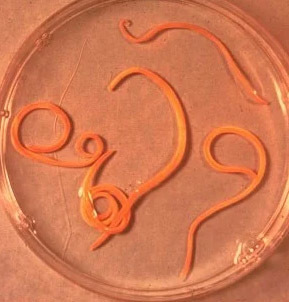Today, science knows of about 280 species of worms to develop, and to live in the human body, sponges in various organs and tissues. The frequency of infection with worms of the people depends on the climatic and socio-economic conditions of certain regions (in the under-developed countries, especially in those that lie in the tropical and subtropical Zone, the level of parasitic infections was significantly higher than in economically developed countries).
Methods of infection of the people deworm:
- Bioelements supply (infection of animals).
- Contagious Helminthiasis (sexually from person to person).
- Geohelminths (diseases caused by parasites, one of the leading life-cycles in the earth).

Factors influencing the symptoms of Helminthiasis
A possibility of the penetration of the parasites into the body:
- The degree of adaptation of the worm to the human body;
- The density of population (number) parasitic individuals;
- The habitat of the worm (tissue parasites live in the thickness of the bodies soft parts, and translucent life in the strip of light hollow). Some helminths in different phases and prosvetnuû substance and Form. The larvae and developing stages of the worms that usually cause a pronounced pathological changes.
If there is no reinfection, the number of adult parasites is not increased in the human body. This specificity of helminthic infestation differs from diseases, the organisms, by bacteria, viruses, fungi and protozoa.
Worms in humans: symptoms
Helminthiasis is a disease that is characteristic for the Phase 2 current (acute, from two weeks to two months) and chronic (several months to several years).
Symptoms of the acute Phase of Helminthiasis
The first signs of the disease may be in different periods (usually after 2-3 weeks, when ascariosis – away after 2-3 days, and in the case of filariasis incubation period of 6-18 months may take).
In the acute Phase of parasitic infection the most typical Symptom of an allergic reaction occurs (for the production of antibodies to antigens of migratory larvae of the parasite). Often arise is in the case of the worms, the infected humans on the skin, itchy skin rashes, tend to be relapsing course, the increase in the regional lymph nodes, pain can occur in generalized or local edema, muscle and joint. Also migrating larvae of the parasite cause pain in the chest, cough, difficulty in breathing, disorders of stool, nausea, and vomiting.
In the meantime, the acute Phase of Helminthiasis can lead to serious injury (severe Form of pneumonia, Hepatitis, allergic myocarditis, hepatosplenomegaly (enlarged liver and spleen).
In the blood the number of eosinophils (eosinophilia) is increasing and interferes with the normal quantitative relationship between Protein fractions (dysproteinemia).

Signs of chronic Helminthiasis
Symptoms of the chronic Phase depends on the body "inhabited" parasites, but also play an important role, their size and number.
So, in the case of parasitism in the intestines of individuals with the disease can be asymptomatic (with the exception of infections is very large parasites). The characteristic features of the chronic Phase of intestinal Helminthiasis diseases are diarrhea. In children to a greater extent Standard asthenoneurotic and pain syndrome pronounced. In the case of massive infestation, the Ascaris perhaps the development of intestinal obstruction, jaundice and pancreatitis.
Consumes all of their livelihood necessary substances from the body of the host, the worms cause indigestion, poor Absorption of vitamins, minerals, carbohydrates, proteins, and fats. At the same time, the food of the vital activity of the worms, the normal microflora of the intestine to inhibit and reduce the body's own immune system.
In humans, the helminthiasis, due to the weakened immunity and enhanced the process of cell division (investigation of the permanent restoration of the damaged parasite tissue) increased significantly the risk of malignant tumors increases.
Types of worms, parasites in the human body
Pathogens human Helminthiasis are 2 types of worms: round (nematodes) and flat (tape worms and flukes).
Roundworms
Pinworms
Parasites, causing enterobiosis is small (to 10 mm) thin cavity radiator worms, with grey-white coloring. The infection occurs through the alimentary (through the mouth). The reason for this – the dirty hands. The eggs of the parasites can be animals on the earth, the fur of infected, Can unwashed and fruit, etc. however, there are cases in enterobiose samsarajade (especially in children), which are due to scratching itchy areas and subsequent ingestion of eggs. The larva pinworms develops within two weeks in the digestive tract. Turned into an adult individual, worm parasitizes in the lower divisions of the small intestine and the upper part of the colon.

Ascaris
Ascaris is a parasite fusiform shape of the red-yellow color, achieved in the adulthood of 40 cm (females) and 15-25 cm (males). Without suction cups or other devices Ascaris attached, able to make their own edible compositions. Eggs held in the females of the parasite, together with the feces.
The infection ascariasis happens when you ingestion of the Mature eggs together with the water, or unwashed fruits and Can, on which the particles of the soil. After the penetration of the eggs in the intestine of the Mature go of the larvae. Then, penetration in the intestinal wall, reaches the blood stream, the heart, and from there into the lungs inhaled. Through the alveoli larvae by the nematode Airways again penetrates into the oral cavity. After re-ingestion of the parasite in the small intestine, where the development of the adult individual. The worm lives for 12 months, then dies and stands out together with the feces. In the intestine of a host's life can be as one, and several hundred individuals.
Whipworm
Whip worm, the causative agent of trichuriasis, white worms, parasitic in the initial part of the colon and reached a size of 4-5 cm parasite Feeds on blood and tissue of the mucous membrane of the rectum.
The eggs of whipworms, held the females on the walls of the intestine, to go out together with the kalovymi masses. Their development takes place in the environment (optimally – in the ground). The eggs with Zürn penetrate in them the larvae of the parasite into the body through the alimentary, through dirty hands, with water, or with unwashed fruits and Can.

Trichinella
The causative agent of trichinosis, a small, round worms, up to 2-5 mm long. The infection occurs through the consumption of poorly roasted meat (pork, brenfleisches, wild boar or). Penetration into the intestine, the larva of the parasite Matures 3-4 days until the state of maturity of the individual. The life expectancy of the worm is 40 days, after which the parasite dies. Prosurvival intestinal wall, the larvae penetrate the bloodstream and in all the organs of the human body, lodged in the muscles. In this case, the most common homeopath is.and on the respiratory and facial muscles, and the muscles-sgibateli extremities
In the first days after infection, patients complain of pain in the abdomen. Then, after about 2 weeks, the body temperature rises to 39 ° to 40 ° C, on the skin itchy skin rashes, muscle pain develop, the face swells. In this period, in the case of massive infestation, consists of an a significant risk of lethality. After about a month, the healing occurs. The parasite is encapsulated in a spiral shape, according to which, within a period of two years dies.
Hookworm, and American hookworm
These two parasites are similar to each other according to biological characteristics, but also by diseases. With this context, they decided to unite under the General title (hook worm). The worms reach a length of 10-15 mm, parasitize in 12-point colon. It should be noted that this is one of the most common, but at the same time, and only rarely by parasites. The larvae of the worms penetrate the human body through the skin by contact with infected soil. Further, in the bloodstream, you, so, like thread worm, Hiking in the lungs, and then, through the bronchi, together with otharkivajushche mucus in the digestive tract. Hookworm parasites in the gut, fixing the amount of the intestinal wall. The parasite that feeds exclusively on blood, biting through the mucous membrane of the blood to the skin vessels, the injection end protivosvertawati component. Per day adult individual, on average, of 0.05-0.35 ml of blood can absorb. Therefore, the characteristic is the most Symptom of Helminthiasis, an iron-deficiency anemia, as well as the change in the ratio of protein fractions (dysproteinemia) is.
Flatworms
A Tape Worm
It is one of the biggest worms to the length of 10-20 meters. Disease, the information of the parasite, as diphyllobothriasis. The development cycle of the worm starts with fresh water fish or crustaceans. In the human body, the final boss wide lentetsa, the larva coincides with caviar or infected fish fillet. The reach of the small intestine, the parasite attaches itself to its wall, and within a period of 20-25 days to grow to the maturity of the individual.
Hepatic Fluke
The parasite, the caller opisthorchiasis is a flat worm reaches a length of 7-20 mm. it should be noted that more than 50% of cases, infection of the hepatic Fluke (it is also called cat Fluke) on the residents of Russia. To develop the larvae of the parasite in the snails) after the penetration of the eggs in fresh water (from the you. Further you penetrate into the body of the fish (carp, crucian carp, bream, roach). Human infection occurs through the consumption of infected meat fish, not sufficient heat treatment. The larva hepatic shovel from the small intestine penetrates into the bile, bile ducts and the gall bladder, fixing with the help of two suction cups.
Cattle and swine tsepen
These are almost identical in their structure, parasites reach a length of 5-6 meters. The infection teniarinhozom and teniasis by eating meat from cattle or pig meat contaminated with cysticerci (one of the intermediate forms of Helminthiasis). Viable cysticerci, the white bubbles in the sizes of 0.5 cm, attach to the wall of the small intestine of man and for 3 months will turn into an adult individual. Band parasite, consisting of more than 2000 segments, which is constantly growing. In finite segments, the eggs, torn down, and even move through the colon to the Anal hole, and then crawl out of the Anus, or in the external environment with the feces. The characteristic symptoms of Helminthiasis is a functional disorder of the digestive tract.
Echinococcus
For this parasite, man is a product of the host. The worm is a parasite in the human organism in the Form of fins. The final host of Echinococcus – a Wolf, a dog or cat. The infection occurs through the digestive when in contact with the animals and with the objects of the environment, seeding the eggs of the Echinococcus. After penetration into the gut out of them onkosfery (shestigrannye larvae) develop. From the intestine they penetrate into the bloodstream and throughout the body.
Al'veokokk
This parasite, as a kind of cyst, the cause is one of the most dangerous Helminthiasis (of alveococcosis), the the flow by gravity, similar to cirrhosis and liver cancer. The infection occurs by the penetration of hexacanth (eggs with Zürn larvae) in the intestine. Because the Embryo leaves the egg and penetrate in the intestinal walls, penetrate into the bloodstream. Furthermore, the bloodstream parasite is widespread in all tissues and organs of the body (most commonly in the liver is localized). There are larvae begins the main phase of the development (formed multi-cellular Blase, labrocyte). In each chamber, embryonic head contains the parasites, continue to develop gradually. Euro city – this is a very aggressive Formation, due to the ever-increasing rising bubbles, as well as the ability to germinate in the liver similar to cancer cells in the metastases.
Diagnosis of Helminthiasis
The diagnosis of parasitic invasions includes the following activities:
- a careful history helps to find out the possible causes of infection;
- Laboratory examinations of feces, blood, content, 12P colon, rectal, and perianal mucosa, muscles, lungs-mucus, bile. In the implementation of the analysis can be identified in eggs, segments or fragments of parasites. Together with the increased blood is also a Signal about the presence of Helminthiasis is eosinophils.
- in the diagnosis of diseases caused by the larval stages or tissue-parasites, are serological tests (Elisa, RSK, indirect reaction of the To\, immunofluorescence analysis, etc.).
- for the detection of helminths, effect on the tissues of the liver by ultrasonography, CT, and endoscopic studies.
Worms in humans treatment
In the acute Phase of parasitic infections, patients, detoxification and de-allocated at the end of therapy. In the case of serious diseases (trematodozov liver, trichinosis) according to medical indications glucocorticoids are used.
As a drug, the specific therapy taking into account the nature of the pathogen protiwogelmintnyje appointed to the special chemotherapy.
Parallel to the Patient to stop taking antihistamines and intestinal chelators is asked. The last Phase of treatment involves the use of probiotics to normalize intestinal flora.
Also, a special diet (food should be easily digestible and contain little fat).
In the time of anthelmintic treatment of patients, strict adherence to personal Hygiene (prevention of contamination) requires. At the same time, many of the helminthoses treatment of all family members and persons with infected in constant contact to pull.








































